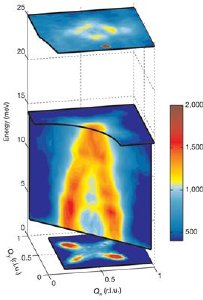Mar 17 2011
New evidence suggests fluctuating magnetic stripes are the cause of mysterious hourglass magnetic spectrum of high temperature superconductors.
Scientists at Oxford University and the Institut Laue-Langevin have used neutrons to probe the magnetic glue thought to produce high temperature superconductivity and have identified stripes of magnetic moments and charge as the cause of a strange hourglass-shaped magnetic spectrum. Their findings, reported in Nature, will aid the search for a model of high temperature superconductivity.
 Neutron scattering intensity maps of the magnetic excitation spectrum of La5/3Sr1/3CoO4.
Neutron scattering intensity maps of the magnetic excitation spectrum of La5/3Sr1/3CoO4.
Current research into the origins of high temperature superconductivity found in a large class of copper oxide compounds centres on the motion of atomic magnetic moments. Fluctuations of these moments are believed to create an attractive force which binds electrons in pairs and allows them to move around unimpeded giving rise to superconductivity.
Recent debate has focused on the cause of an unusual hourglass shape found in the spectrum of these magnetic fluctuations. The origin of this pattern, which is found in many if not all high temperature superconductors, is thought to relate to an alternating pattern of spin and charge stripes found within the atomic layers. However, efforts to prove this link have been hampered by the weakness of the magnetic signal from the superconductors and by changes in the spectrum caused by superconductivity.
The team instead turned their attention to an insulating cobalt oxide with a similar magnetic stripe pattern. Using neutron scattering at the ILL, the flagship centre for neutron science, the scientists measured the atomic-scale fluctuations in its magnetism and uncovered the same hourglass pattern in the data. Their results provide strong evidence that magnetic stripes are the cause of the hourglass spectrum and play an important role in high temperature superconductivity.
"Our cobalt oxide compound is a magnetic look-alike for the high temperature superconductors," says Professor Boothroyd (Oxford University). "Its lack of mobile electrons prevents it from becoming superconductive, allowing us to use neutron scattering to look in detail at nano-scale fluctuations in the magnetic motion without the complicating effects of superconductivity. The experiment allows us to isolate the source of the much-debated hour-glass spectrum."
This represents an important discovery for those aiming to model the origins of superconductivity.
"Future models must now incorporate these magnetic stripes, says Dr Paul Freeman, formerly from the ILL, now at the Helmholtz Zentrum Berlin. "And with these simple cobalt oxide compounds, we have an ideal candidate for further research into understanding the links between magnetism and high temperature superconductivity."